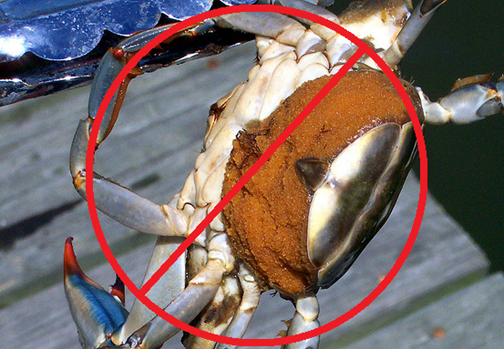Crabbing Rules and Regulations
To make your crabbing experience as fun and as smooth as possible, rules and regulations for your specific crabbing location should be followed. You definitely don’t want to spoil your crabbing expedition by having to pay a fine, or even worse, go to jail. Some regulations limit the amount of crab you are allowed to take home, the type of crab (male versus female), whether or not you need a license, what types of traps you are allowed to use, etc. There are limits on number of traps you can set but as a recreational crabber, you probably won’t reach those limits.
As far as restrictions on the method of crabbing, you can think of it this way: the more crabs you plan on catching, the stricter the rules. Crabbing with a hand line and dip net usually has less restrictions than if you are crabbing with a vessel (boat) and several crab pots. Buoys for the crab pots need to be labeled properly. There are only a certain number of pots you can have. They must be within a certain size, etc.
Here are some summarized rules and regulations for various locations you should to follow as a recreational crabber. Please visit their sites to learn more. Visit them often as the rules may change.
All states in the U.S. prohibit anybody from taking sponge crabs (females bearing eggs). The baby crabs are innocent. Let them live and catch them later! Here is what a sponge crab looks like:
1) Connecticut:
Minimum shell width (spike tip to spike tip):
5 inches – Hard shell
3 1/2 inches – Soft shell
Daily creel limit: None
Open Season: May 1 – November 30
No license is required for personal use of crabs (not for sale).
http://www.eregulations.com/connecticut/fishing/recreational-fishing-bait-species-blue-crab-lobster/
2) Delaware:
Minimum shell width (spike tip to spike tip):
5 inches – Hard shell
3 1/2 inches – Soft shell
Daily creel limit: 1 Bushel
Residents pay $8.50 for a required fishing/crabbing license.
http://www.dnrec.delaware.gov/
3) Florida:
Minimum shell width (spike tip to spike tip):
No limit for blue crabs, 2 3/4-inch claw for stone crabs
Daily creel limit: 10 gallons whole per person for blue crabs, 1 gallon of claws per person or 2 gallons per vessel, whichever one is less
Open Season: Varies per location
Annual saltwater or freshwater fishing license required ($17.00).
http://myfwc.com/fishing/saltwater/recreational/
4) Louisiana:
Minimum shell width (spike tip to spike tip):
No size limit for recreational crabbing
Daily creel limit: 12 dozen per person
No license required for recreational crabbing. However, certain wildlife management areas may require a basic fishing license ($9.50 for resident).
http://www.wlf.louisiana.gov/fishing/recreational-crabbing
5) Maryland:
Minimum shell width (spike tip to spike tip):
5 inches – Hard shell
3 1/4 inches – Soft shell
Daily creel limit: Without a license: 2 dozen male hard crabs and 1 dozen soft crabs. With a license: more than 2 dozen with a limit of 1 bushel, more than 1 dozen with a limit of 2 dozen soft crabs
For use of crab pots as a recreational crabber, you need a license that costs $5.00. Use of hand lines and/or dip nets only does not requirement a license.
http://dnr.maryland.gov/service/fishing_license.asp
6) Washington State:
Minimum shell width (Size is measured in a straight line across the back (caliper measurement) immediately in front of, but not including the tips):
Varies
Daily creel limit: Varies
Open Season: Varies per location
Fishing license required and catch records required to be reported as well.
http://wdfw.wa.gov/fishing/shellfish/crab/
7) California (Info for Dungeness crabs only):
Dungeness crab CANNOT be harvested from San Francisco Bay or San Pablo Bay.
Minimum shell width (Size is measured in a straight line across the back (caliper measurement) immediately in front of, but not including the tips):
5.75 inches – Hard shell
Daily creel limit: 10 crabs per day
Open Season: November 2 – July 30
Sport fishing license required.
https://www.dfg.ca.gov/licensing/fishing/fishdescrip.html
https://www.dfg.ca.gov/marine/mapregs5.asp#crab
8) Oregon:
Minimum shell width (Size is measured in a straight line across the back (caliper measurement) immediately in front of, but not including the points):
5.75 inches – Dungeness, Red rock crabs have no size limit.
Daily creel limit: 12 male Dungeness crabs and/or 24 red rock crabs per person per day
Open Season: Entire year
Requires a shellfish license
http://www.dfw.state.or.us/mrp/shellfish/regulations.asp
http://licenseinfo.oregon.gov/?fuseaction=license_seng&link_item_id=14626
9) North Carolina:
Minimum shell width (spike tip to spike tip):
5 inches, 6 ¾ -inch maximum size limit for females from Sept. 1-April 30
Daily creel limit: 50 crabs per day per person, not to exceed 100 crabs per vessel per day.
No license is required for specified methods of crabbing.
http://portal.ncdenr.org/c/document_library/get_file?uuid=2704a0d9-1d02-4b9f-a548-c1f8a0fab26f&groupId=38337
10) South Carolina:
Minimum shell width (spike tip to spike tip):
5 inches – Hard shell
Only one Stone crab claw is allowed to be harvested per stone crab provided that the claw is at least two and three-fourths inches in length or larger measured by a straight line from the elbow to the tip of the lower immovable claw finger.
Saltwater license required.
https://www.dnr.sc.gov/licenses/pdf/CrabsFY2013.pdf
Daily Catch Units
If you were wondering about the bushel versus gallons units that measure your total catch, 1 bushel is equal to about 9.3 gallons. Therefore, it would be useful to know the volume of the container you plan on putting your crabs in.

